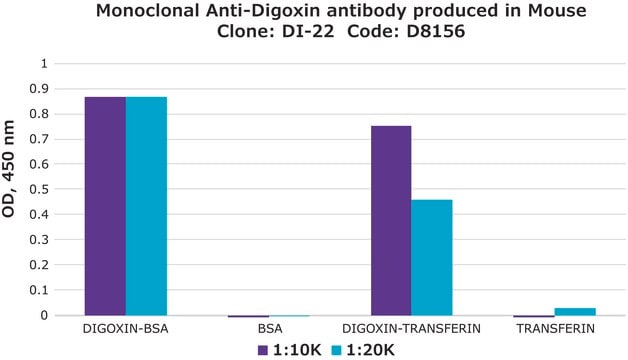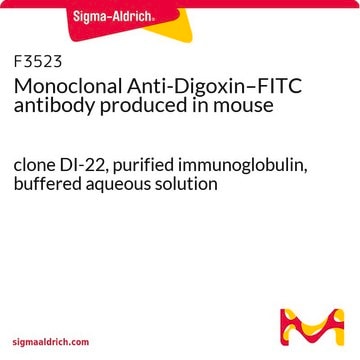11207733910
Roche
Anti-Digoxigenin-POD, Fab fragments
from sheep
Sinónimos:
anti-digoxigenin, digoxigenin
About This Item
Productos recomendados
origen biológico
sheep
Nivel de calidad
conjugado
peroxidase conjugate
forma del anticuerpo
F(ab′)2 fragment of affinity isolated antibody
tipo de anticuerpo
primary antibodies
clon
polyclonal
formulario
lyophilized (clear, brown solution after reconstitution)
envase
pkg of 150 U
fabricante / nombre comercial
Roche
temp. de almacenamiento
2-8°C
Descripción general
Especificidad
Aplicación
- Dot blot
- ELISA
- Immunohistocytochemistry
- In situ hybridization
- Western blot
Nota de preparación
Working concentration: Working concentration of conjugate will depend on the application and substrate. The following concentrations should be taken as a guideline: Dot blot: 150 mU/ml
- ELISA: 50 to 150 mU/ml
- Immunohistocytochemistry: 250 to 500 mU/ml
- In situ hybridization: 1.5 to 7.5 U/ml
- Southern blot: 150 mU/ml
- Western blot: 250 to 500 mU/ml
Working solution: 100 mM Tris-HCl, 150 mM NaCl, pH 7.5.
1% Blocking reagent (w/v), 1 to 5% heat inactivated fetal calf serum (v/v) or sheep normal serum can be used for reduction of unspecific binding.
Reconstitución
Otras notas
Not finding the right product?
Try our Herramienta de selección de productos.
Palabra de señalización
Warning
Frases de peligro
Consejos de prudencia
Clasificaciones de peligro
Skin Sens. 1
Código de clase de almacenamiento
11 - Combustible Solids
Clase de riesgo para el agua (WGK)
WGK 1
Punto de inflamabilidad (°F)
does not flash
Punto de inflamabilidad (°C)
does not flash
Certificados de análisis (COA)
Busque Certificados de análisis (COA) introduciendo el número de lote del producto. Los números de lote se encuentran en la etiqueta del producto después de las palabras «Lot» o «Batch»
¿Ya tiene este producto?
Encuentre la documentación para los productos que ha comprado recientemente en la Biblioteca de documentos.
Los clientes también vieron
Artículos
Digoxigenin (DIG) labeling methods and kits for DNA and RNA DIG probes, random primed DNA labeling, nick translation labeling, 5’ and 3’ oligonucleotide end-labeling.
Nuestro equipo de científicos tiene experiencia en todas las áreas de investigación: Ciencias de la vida, Ciencia de los materiales, Síntesis química, Cromatografía, Analítica y muchas otras.
Póngase en contacto con el Servicio técnico








